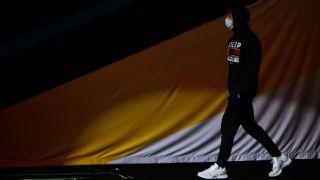|
On July 8, 2020, Stanford wrestling coach Jason Borrelli was on the back nine during a round of golf when one of his assistant coaches sent him an unusual text. Why are we locked out of our social media accounts? "That's weird," Borrelli thought. He didn't have an answer. The assistant reached out to a member of Stanford's sports information department and was told the social media accounts were down for routine maintenance. Borrelli didn't think much of it, but on the 18th hole, he got another message. What's this emergency zoom meeting we need to be on? "I thought maybe there was just some announcement everyone needed to hear, but it was odd," Borrelli said. "So I went back in and read the email again and this is when it hit me like a ton of bricks. It had head coach and assistant coaches from 11 programs. There's no football, there's no basketball. Well, this isn't good. I still thought, 'There's no way -- no way. They're not cutting our program." Then his wrestlers started asking him why they, too, had an emergency zoom call. For Borrelli, that served as unofficial confirmation of the scenario he had been trying to convince himself wasn't happening. A short while later, athletic director Bernard Muir made it official. Within minutes of the coaches and athletes finding out their sports would be cut, the university sent out a press release, dressing it up as an open letter from president Marc Tessier-Lavigne, provost Persis Drell and Muir, to announce the elimination of men's and women's fencing, field hockey, lightweight rowing, men's rowing, co-ed and women's sailing, squash, synchronized swimming, men's volleyball and wrestling. "We were still on the zoom call when I started getting texts from people about it," Stanford wrestler Shane Griffith said. "How could they release this to the public before even some of [the athletes] knew what was happening? That was heartbreaking." Athletes were informed that their scholarships would be honored should they choose to remain at Stanford to finish their degrees, but the sports would no longer be sponsored after the 2020-21 academic year. Griffith wasn't the lone athlete with the potential to one day compete for an Olympic spot to see their world turned upside down. "These 11 programs consist of more than 240 incredible student-athletes and 22 dedicated coaches," the release said. "They were built by more than 4,000 alumni whose contributions led to 20 national championships, 27 Olympic medals, and an untold number of academic and professional achievements." In an attached FAQ, the school said the decision was "considered a last resort, only to be undertaken if all other viable avenues had been exhausted" and "comes down primarily to finances and competitive excellence." Those lines rang hollow for people associated with Stanford athletics -- including Olympians, current and former pro athletes, Stanford athletics hall of famers, current students, coaches and staff members. The idea that all viable avenues were exhausted despite keeping the overwhelming majority of the stakeholders in the dark was easy to dismiss out of hand, while independent fundraising efforts and athletic performances since, like Griffith winning a national championship in March, have exposed major holes in the logic presented in the original announcement.  After the news broke, a group of alumni that calls itself 36 Sports Strong formed to attempt to reverse the university's decision. The group counts Andrew Luck (football), Julie Foudy (soccer), Kerri Walsh Jennings (volleyball), Josh Childress (basketball), Janet Evans (swimming) and Michelle Wie (golf) among a large list of high-profile advocates for the cause. In an interview with ESPN on Friday, leaders from the group said they have received more than $50 million in pledges to save the sports, are close to fully endowing four and are optimistic they will be able to raise the remaining money needed to allow the 11 sports to become financially self-sustaining in the near future. "I'm looking at the numbers and we believe that we are between 55 and 60% of the way there based on what we have," said spokesman Jeremy Jacobs, a former Stanford volleyball player. "And this is in six months. So give us a couple of years and we think we can get there." One of the main sources of frustration for the 36 Sports Strong group, along with the impacted student-athletes and coaches, has been a steadfast refusal by the administration to discuss possible solutions. On Tuesday, however, the group is set to virtually meet with university leadership, at the request of Tessier-Lavigne, to discuss the group's petition. Stanford declined ESPN's request for an interview with someone familiar with the university's decision-making process, but issued a statement in which it disagreed with 36 Sports Strong's financial evaluation. "Discontinuing sports was an extremely painful decision, and it was driven by the financial challenges of supporting twice as many varsity teams as the Division I average at the level we believe is essential for our student-athletes to excel," according to a Stanford spokesperson. "The fundraising numbers cited by groups that have organized to reinstate individual sports and all 11 sports have significantly underestimated the total amount of funding required to support the programs they wish to reinstate and, in most cases, do not appear to be accounting for the need to adhere to Title IX gender equity requirements. "President Tessier-Lavigne looks forward to meeting with the leaders behind the petition to ensure their perspectives are thoroughly heard." The alumni group doesn't just want to be heard -- it expects a substantive discussion about how to save the sports and work on implementing a model that will allow them to thrive long-term. "I don't think we need a meeting just to be placated and soothed and be told that we've been heard," said former NBA player Adam Keefe, a 2000 induction into the school's athletic hall of fame who now works as a financial advisor. "We've had that meeting before. So the fact that [Tessier-Lavigne] reached out lends us to believe that they're actually trying to figure out how to right this wrong, and how to restore the institutional credibility that they've lost to this process. "I think after digging, really deep diving into the finances, it is very clear that this is not a financial decision. Cutting the 11 Sports will not eliminate the deficit in the athletic department." After reviewing filings from the Department of Education, 36 Sports Strong estimates cutting the 11 sports, when taking into account the $23 million in endowments the cut sports already had, will save the Stanford athletic department $4.5 million a year -- about 3% of the athletic department's annual budget. "If Stanford says our numbers are wrong, they should prove it," Jacobs said. "This entire process has lacked transparency and the school continues to provide no justification for its numbers. We are asking to work with them to come up with a solution -- and not be shut out of the process like we have been so far." With an understanding that cutting the 11 sports will have a minimal impact on the athletic department's finances, some members of the Stanford athletic department have reasoned that the motivation lies elsewhere. Namely in the form of admissions slots. By fielding 36 varsity teams with roughly 850 athletes, Stanford has one of the largest athletic departments in the country and says 12% of its undergraduate population is made up of athletes. Each of them arrives with impressive academic achievements, however, the admissions threshold for a recruited athlete is not as stringent as that for the school's general population. That dynamic has resulted in a belief that those driving the decision to cut the sports did so in order to allocate those 240 admissions slots to students with different academic profiles. Borrelli said he raised the admissions issue with Muir after the announced cuts. "I asked him, 'Is this about admissions? Do they want admission spots back?' And he said, 'No, that never came up,'" Borrelli, who was named the 2021 Pac-12 wrestling coach of the year, said. "And they've doubled down on that so many times where they've said it's not about that. 'It's about finances, it's about finances, it's about competitive excellence. It's about these things.' We've given them so many opportunities to tell us that it's about admissions or what it's really about." What the cuts are about doesn't ultimately make a difference for those who will be impacted, including Griffith. After learning of the cuts, Griffith realized he needed to load up on courses in order to graduate this summer, so he could have the opportunity to leave as a graduate transfer to wrestle elsewhere in 2021-22. Would it be worth wrestling on top of that? It wasn't immediately obvious, especially when considering Santa Clara County's strict COVID-19 protocols made training for wrestling even more difficult. Eventually, he and his teammates moved forward with a final year and decided they would only wrestle in black singlets without any identifying marks, as a way to protest Stanford's decision to cut their sport. "We weren't going out there to represent [Stanford]," Griffith said. "Because essentially they don't care about us at all. They cut us, they don't believe in us." The Cardinal didn't wrestle competitively for the first time this season until late January, giving the team just weeks to prepare for the Pac-12 and NCAA championships. That didn't stop Griffith from turning in arguably the most memorable performance in Stanford wrestling's 104-year history. Seeded eighth at the NCAAs due to his comparative lack of matches with the rest of the field, Griffith marched to the final at 165 pounds, where he won in a nationally televised match to become Stanford's second-ever national champion. Chants of "Save Stanford wrestling" echoed throughout the arena and his post-match interview further amplified the message. While Griffith is set to graduate and transfer, his younger teammates don't have the same luxury. They were sold on the opportunity to receive a Stanford education while extending their wrestling careers. Now, they're faced with a difficult decision: Stay for the Stanford degree or leave to extend their wrestling career. Unless, of course, 36 Sports Strong makes its case and the university reverses its decision.
|

